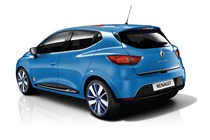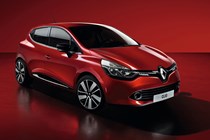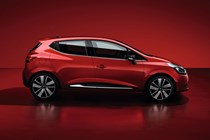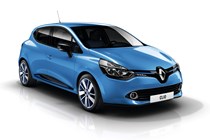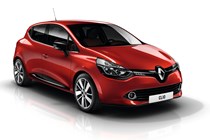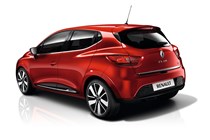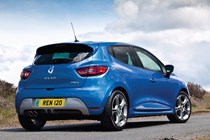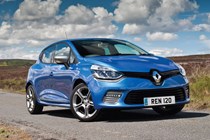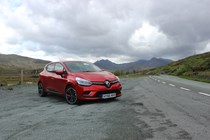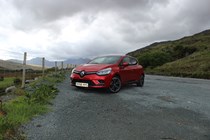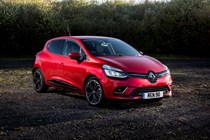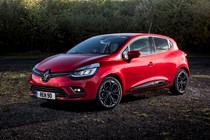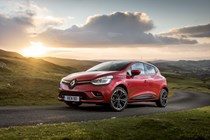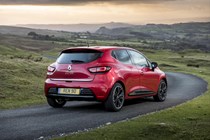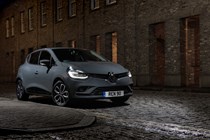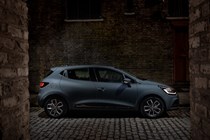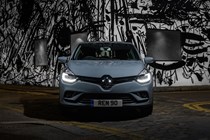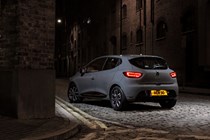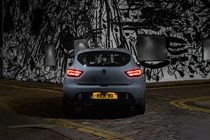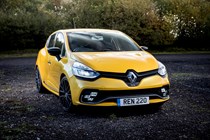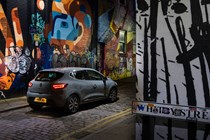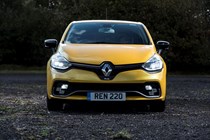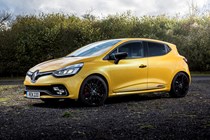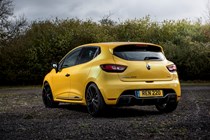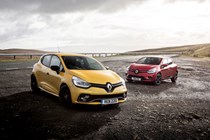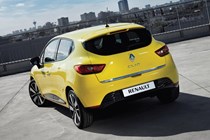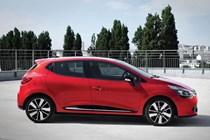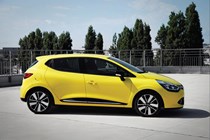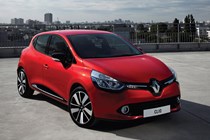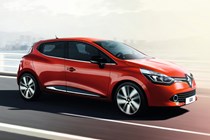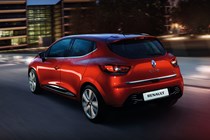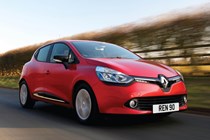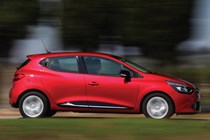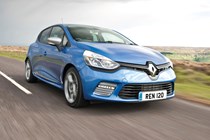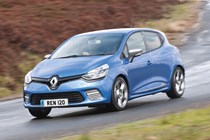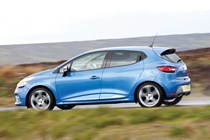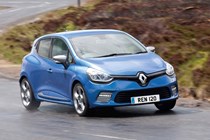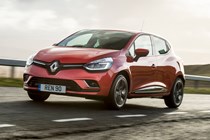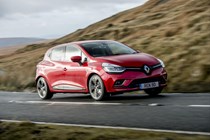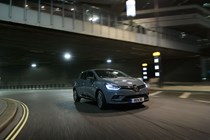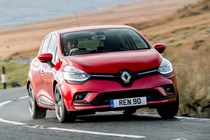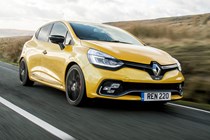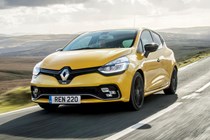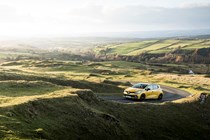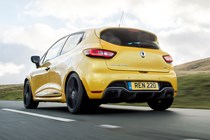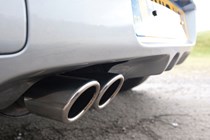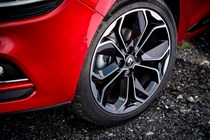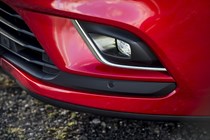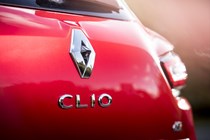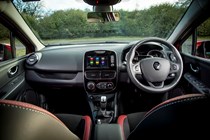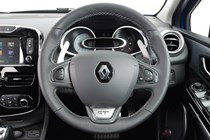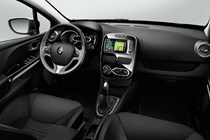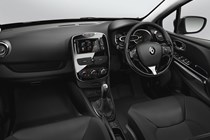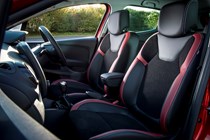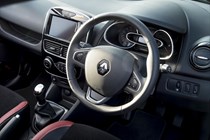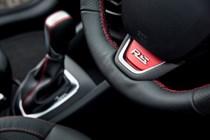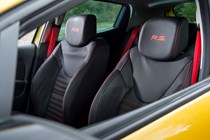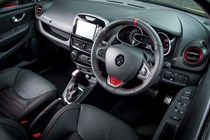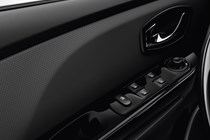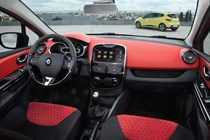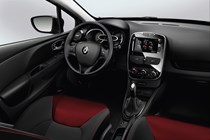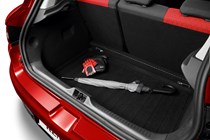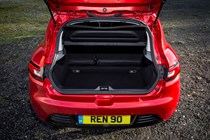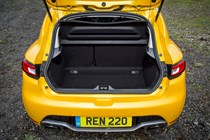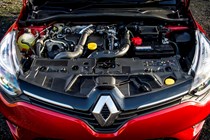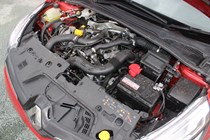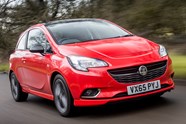
Renault Clio Hatchback (2012-2019) review
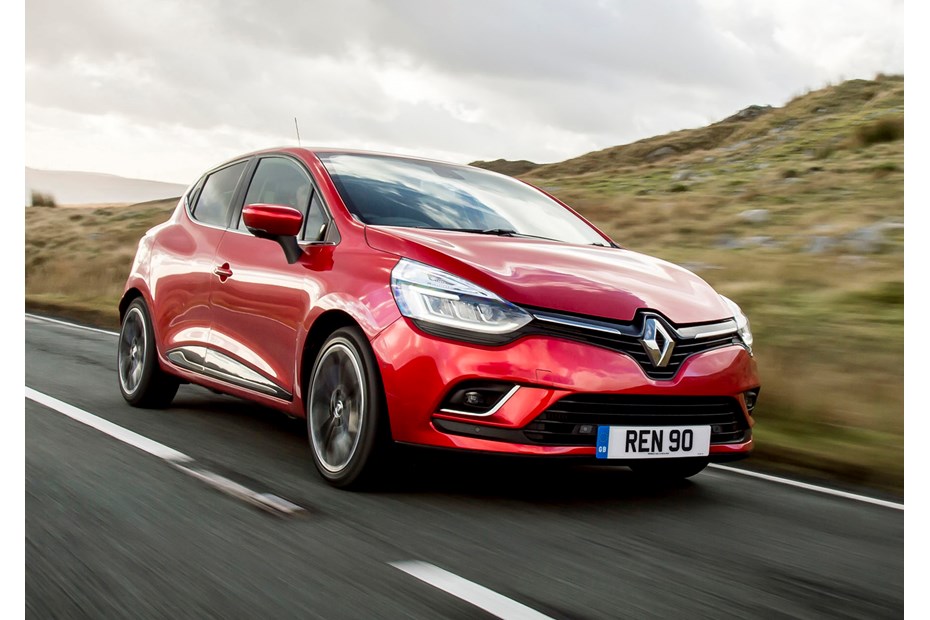
At a glance
| Price new | £11,145 - £22,795 |
|---|---|
| Used prices | £1,891 - £11,638 |
| Road tax cost | £20 - £195 |
| Insurance group | 3 - 28 |
Get an insurance quote with

|
|
| Fuel economy | 46.3 - 57.6 mpg |
| Range | 465 - 871 miles |
| Miles per pound | 6.8 - 7.4 |
| Number of doors | 5 |
| View full specs for a specific version | |
Available fuel types
Petrol
Diesel
Pros & cons
- Stylish and modern to look at
- Plenty of kit and tech for the money
- A comfortable ride and fine handling
- A wide span of model variations
- Engines are efficient and punchy
- Interior plastics are disappointing
- Not as practical as newer rivals
- Numb steering robs it of fun factor
- Add options, and things can get expensive
- Renaultsport models aren’t sharp enough
Renault Clio Hatchback (12-19) rivals
Overview
The fourth-generation Renault Clio is a very attractive second-hand car. You can pick up a tatty, high-mileage example for less than £4,000 – but what’s even better is, if you want a well-cared for, low-mileage one, you barely need to spend any more than £6,000.
Part of the reason why the Clio IV is such a cheap used car is because Renault sold so many of them. The Mk4 Clio was one of the UK’s most popular superminis when it was new, which followed the trend set by its forebears. More than a million Clios have found homes in Britain since the original model was launched in the early 1990s.
For good reason, too. They’re well-packaged, fun-driving small cars – and the fourth-generation model boasted even more stylish looks, economical turbocharged petrol and diesel engines, an excellent crash safety rating and a practical interior.
So, whether you’re a new driver looking for your first set of wheels or a family buyer in need of a small and safe runabout for your children, the Renault Clio will suit you. Scroll down and read our detailed used review to find out why.
We’ll address all the car’s strengths and weaknesses, as well as the most common mechanical faults that plague it, so you can nail down a deal with confidence.
Renault Clio IV known faults and common issues
Renault didn’t have the best reliability record when the Clio IV was launched, but this little supermini defied its maker’s image. Granted, early cars were a little more prone to faults as Renault was still figuring out how to build them, so our advice would be to shop for as new a model as possible – preferably a facelifted car built after 2016.
We’re not concerned about the fragility of the Clio’s running gear, though. Providing your car has been well-maintained, it won’t be any less reliable than any other supermini. The engines, for example, were used in other Renaults, Dacias, Nissans and some Mercedes cars – and they’ve proved to be largely dependable.
Buying guide
Common issues and what to look for if you’re considering buying one
1. Brake hoses
The DVSA has issued two recalls for the Mk4 Clio’s braking system. The problem was twofold – the protectors for the front brake hoses and rear brake cylinders were fitted incorrectly on some cars which could cause the fluid to leak. If it did, your car wouldn’t be able to stop. Ensure this recall work has been done before handing over any cash.
2. Suspension wear
The Mk4 Clio seems to suffer from weak suspension. Again, there are two faults. The suspension springs are notorious for corroding and snapping, so make sure you get your head in your potential car’s wheelarches and check them over. The suspension bushes also seem to be a little weak, so listen for clonks on your test drive.
3. Timing chain maintenance
The Clio’s 0.9-litre petrol engine has a timing chain that needs to be replaced at least every 100,000 miles. If you’re shopping for a high-miler and you hear a ‘chattering’ sound coming from the engine, it’s highly likely that car’s timing chain has stretched. If left unchecked, the engine will fall out of sync and destroy itself.
4. Electrical issues
Owners report lots of intermittent electrical faults with this generation of Clio. The most common ones include faulty windscreen wipers, dicky digital instrument displays and broken electric windows. One owner on this Renault forum even reported that when he put his car into reverse, the boot unlocked! If you’re mechanically confident, check the car’s wiring connections and hunt for broken wires. If not, simply walk away.
5. Gearbox fault
The Clio RS hot hatch has an irritating fault with its automatic gearbox. You get an error message on the dash that reads ‘check auto gearbox,’ and the transmission won’t give you all its gears. There are two fixes for the problem. If you’re lucky, you’ll get away with just changing the battery. If you’re unlucky, you’ll to spend a few hundred pounds on a new transmission control unit.
6. Bodywork
The Clio’s affordability and easy driving experience means they’re favourites for new, inexperienced drivers – and those drivers aren’t always aware of their cars’ dimensions. Check for minor bodywork scuffs and alloy wheel damage.
7. Ignition coils
The 1.2-litre Clio has a common issue with its ignition coils. They’re prone to failure, which will make the engine stumble and splutter. They’re £40 apiece – and they should be relatively easy to replace at home because they’re bolted to the top of the engine.
8. Sat-nav woes
This is more of a failing on Renault’s behalf from the factory rather than a reliability concern that’s developed throughout the car’s life. The sat-nav system is rather badly designed. Not all cars offer the ability to input a full postcode, which can make using it a chore. However, you can upgrade the system with some laptop wizardry.
9. Clogged DPF
The 1.5-litre DCi is notorious for clogging its diesel particulate filter. Check for warning lights on your test drive – the car will tell you if the engine isn ‘t breathing properly. You might be able to clear it out cheaply by driving it or by using a diesel engine cleaner. If not, you’ll need to pay to have it replaced, so proceed with caution.
10. Leaking seals
Check under the carpets in the cabin and the boot and check for moisture. If it’s damp, it’s likely the seals around the door or boot lid have failed. You’ll need to replace them to keep the inside of your car from looking like a swamp.
What models and trims can you buy?
Unlike previous versions of the Clio, the Mk4 is only available as a five-door. However, Renault pinched a leaf from Alfa Romeo’s book and disguised the rear door handles into the C-pillar, so it looks like a sleeker model when viewed side-on. Putting the door handle in the rear pillar does dramatically reduce rear visibility though.
Despite there only being one body style, there’s a broad range of engines to choose from. The petrol engines are badged TCe, with a choice of 75hp and 90hp units. There’s only one 90hp 1.5-litre diesel (badge dCi), however – but it’s available with a choice of manual and automatic gearboxes.
The dCi 90 is particularly efficient, returning up to 57.6mpg. Don’t feel like you need to go for it to unlock the best fuel economy, though. If you’re just using your Clio around town, one of the petrols will suit your needs just fine.
At the top of the range, there’s the Renaultsport Clio. There are two options available with either 200hp or 220hp. However, they’re hamstrung for enthusiasts by an obstructive EDC dual-clutch automatic gearbox – and there’s no manual alternative.
Still, they’re quick: the Clio Renaultsport 220 Trophy can reach 146mph and gets from 0-62mph in 6.6 seconds. The handling will put a smile on your face, too, but as a package it falls short of the Ford Fiesta ST and Peugeot 208 GTi of the same era.
Keep reading to find out whether you should buy a Mk4 Renault Clio. Over the next few pages, we’ll review each aspect of the car, considering its practicality, comfort, fuel economy and performance before we offer our final verdict on the car.



